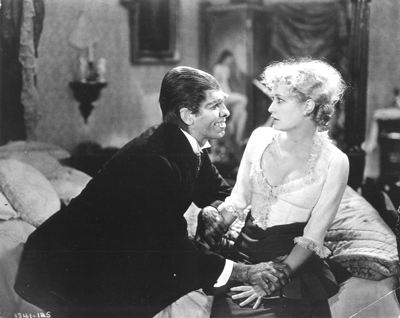Film Forum celebrates social, sexual candor at early Paramount
Hollywood’s motion picture industry has long been considered a purveyor of high-minded civic norms and consequently, the periodic target of reformists’ campaigns against perceived declines in American values.
In 1930, after cinema had entrenched itself as a cornerstone of the nation’s cultural output, as bread lines curled down city streets following the Great Crash, Will H. Hays, an affable campaign manager for former Pres. Warren Harding, led the drafting of The Motion Picture Production Code of 1930, otherwise known as the Hays Code, a set of guidelines that, though not enacted until 1934, governed the content—particularly in matters sexual—of Hollywood films. Before the code was abandoned in 1967, filmmakers who dared to abrogate its strictures about bi-racial couples or French kissing, for example, were censored, or worse, ostracized from the industry.
Consequently, film historians have always depicted the era before the code’s implementation as sort of cinematic golden age of free expression, a premise that New York’s Film Forum is exploring its series “Paramount Before the Code,” about the Hollywood powerhouse responsible for introducing the world to some of the movies’ early giants.
In “Two Kinds of Women,” from 1932, Miriam Hopkins, who, before falling into obscurity, was one of those screen legends, exclaims, “New people, new things, new places…New York! Oh, how I love it!” The most talented actress under contract to Paramount Pictures in the early 1930s, Hopkins was a radiant figure in the daring pre-code days of candid references to sex, drugs and revelry.
Hopkins was dazzling in director Ernst Lubitsch’s comic masterpiece, “Trouble in Paradise.” Film Forum is offering a double-feature of “Dr. Jekyll and Mr. Hyde” and “The Story of Temple Drake,” where, in the first, Hopkins plays a shrewd Cockney barmaid, terrorizing the screen and stealing every scene from Fredric March in the title role and, in the second, an adaptation of William Faulkner’s lurid novel, “Sanctuary,” which really drove the Hays committee to distraction, she plays a Southern belle who is sexually violated.
Designed by Jean Negulesco, later a prominent director, “Temple Drake” is a visual feast, as are so many of these 1930s films. Rumanian-born Negulesco was but one of the many European émigrés who gave Paramount its distinctly European flavor, joining directors Lubitsch, Josef von Sternberg, Rouben Mamoulian, Marion Gering and Hans Dreier, possibly the greatest of Hollywood art directors. Where MGM had its traditional baroque grandiosity, Warner Brothers its proletarian edge, and RKO its literary sensibility, the house style at Paramount was one of ultra-cool, feminized elegance, in which even scenes of impoverishment were suffused in a raffish, soft-focus glamour.
Negulesco also contributed to the eye-catching suave appeal in two Cary Grant musicals, “This is the Night,” in which Grant charmingly croons “Love Divided By Two” (by Paramount’s reliable songwriting team, the underrated Leo Robin and Ralph Rainger) and “Kiss and Makeup,” where Grant, as a cosmetic surgeon prefigures current obsessions with facial makeovers.
Grant also appears with his off-screen lover, Randolph Scott, in the delightful small-town comedy, “Hot Saturday,” as the hunks vying for the affection of Nancy Carroll. Because of its many prominent gay personalities and overall homo-erotic ethos, Paramount could be deemed the gayest of the early Hollywood studios. Gay George Cukor’s hilarious “Girls About Town,” the best of all gold-digger comedies, is sparked by the presence of Lilyan Tashman, a lipstick lesbian, whose figure Cecil Beaton deemed the best in Hollywood. Tashman was known as a rambunctious, off-screen womanizer, with whom no self-respecting lady would ever accompany to the powder room.
Another once-famous star was Wynne Gibson, whom old-time publicists used to describe in her later years as “living in Laguna with her girlfriend.” Gibson, a B actress who once had a vaudeville sister act with Billie Vernon (James Cagney’s wife), always plays a delightful curmudgeon, typically aggravated about them no-good men. She shines in an early masterpiece of women prisoners, “Ladies of the Big House,” especially when she gives Sylvia Sidney a hard time.
None of these sultry stars, however, outshone Marlene Dietrich, whose sheer audacity, particularly when directed by von Sternberg, puts the temptress at her peak, planting a kiss on the lips of a female nightclub patron in “Morocco,” or, in “Blonde Venus,” shedding a gorilla suit to sing “Hot Voodoo” and caressing a chorus girl’s cheek.
Perhaps the wildest Hollywood party of the era was thrown by Carole Lombard, who took over the Venice amusement pier for a shindig at which a paparazzi shot of Claudette Colbert, nestled between Dietrich’s legs, raised eyebrows. In Cecil B. DeMille’s “Cleopatra,” whom she plays as a glamorous, pragmatic, gold digger, Colbert has other telling moments. In DeMille’s jaw-dropping “The Sign of the Cross,” as wicked Empress Poppaea, Colbert flashes her nipples in a milk bath before telling a gal pal to “Take your clothes off, get in here and tell me all about it.” This epic is also notable for the wild “Dance of the Naked Moon,” in which dancer Joyzelle graphically fondles nice Christian girl Elissa Landi in an attempt to seduce her into Roman decadence. (In 1984, when the Lincoln Center Film Society honored Colbert, she irked the organizers by refusing to allow them to show footage from these two films.)
As Poppaea, Colbert is partnered by that homo hambone, Charles Laughton whose performance as Nero, even in 1932, was described by gay Brit critic James Agate, as that of a “big quean (sic).” “Delicious debauchery,” Nero croons, reminiscing about the previous night’s orgy, attended by a naked, male slave. In the grisly “Island of Lost Souls,” Laughton is over the top as H.G. Wells’ Dr. Moreau, torturing comely Richard Arlen, and, in “White Woman,” he repeatedly, unnecessarily, pokes cute Kent Taylor in the tummy. When a director once beseeched Laughton to act more butch, he replied, “I’m paid more for character roles.”
Gay director Mitchell Leisen was a seminal Paramount artist, responsible for the sumptuous design of DeMille’s spectaculars and he helmed “Murder at the Vanities,” with its delightful Sam Coslow ditties “Cocktails for Two” and the scandalous “Marijuana.” Even W.C. Fields got into the act, in “International House.” Arriving at a fantasy China, he asks the perennially nancy Franklyn Pangborn where he is. “Woo Hoo!” cries Pangborn, to which Fields replies, “Don’t let the posy fool you,” before tossing away his boutonniere.
The female stars really gave Paramount a glamour that outshone that of the other studios. Dressed by Travis Banton, the best Hollywood couturier, and photographed by the masters, Lee Garmes, Victor Milner, Leo Tover and Ted Tetzlaff, they had a shimmering sensuousness that made their MGM sisters look heavy and dull. Jeanette MacDonald actually transferred from Paramount to MGM, and it’s instructive to see her transformation, from the sexy comedic minx of “Love Me Tonight” and “One Hour with You” to the sanctimonious, no-fun grande dame Metro insisted upon.
Gorgeous Carole Lombard symbolized the studio’s esprit and, in “No Man of Her Own,” her only film with Clark Gable, written by bisexual Edmund Goulding, she receives the best come-on line from him ever: “Do your eyes bother you?” “No.” “They bother me.” Don’t miss her, moonily gyrating with George Raft to Ravel’s “Bolero” in the 1934 film of the same name. Her no-less ravishing, somewhat B-list blonde counterpart, Thelma Todd—mysteriously found dead from carbon monoxide poisoning in 1936—displays her curvaceous chassis and comic skills in the Marx Brothers’ “Horse Feathers” and “Monkey Business,” where she exults, “I want laughs! I want good times! I want hotcha-cha-cha!”
Then there’s Lyda Roberti in “Million Dollar Legs,” the brilliantly surreal comedy by Joseph and Herman Mankiewicz, which, more than any other film, conveys the unbridled spirit of Paramount fun. As irresistible vamp, Mata Machree, with her hysterical bogus accent (“I bane done do all I can do…in public!”) and singing “It’s Terrific,” this Polish bombshell detonates a hilarity unsurpassed in film history.
On the brunette side, Sylvia Sidney proved the screen’s most effective heartbreaker in the expressionistic “City Streets” and von Sternberg’s “An American Tragedy,” in which, playing the same Theodore Dreiser character that Shelley Winters gratingly essayed in “A Place in the Sun,” she makes you weep over, rather than root for, her being murdered by her ambitious lover. Frances Dee’s cameo-like beauty and grace are featured here as well, as they are in “June Moon,” the rare film adaptation of the George S. Kaufman/Ring Larnder play.
That most prominent dirty blonde, Mae West, is naturally present, and rightly so, as her lusciously licentious “Night After Night” and “She Done Him Wrong” saved Paramount from financial ruin, even as they ushered in that smothering code.
gaycitynews.com
































